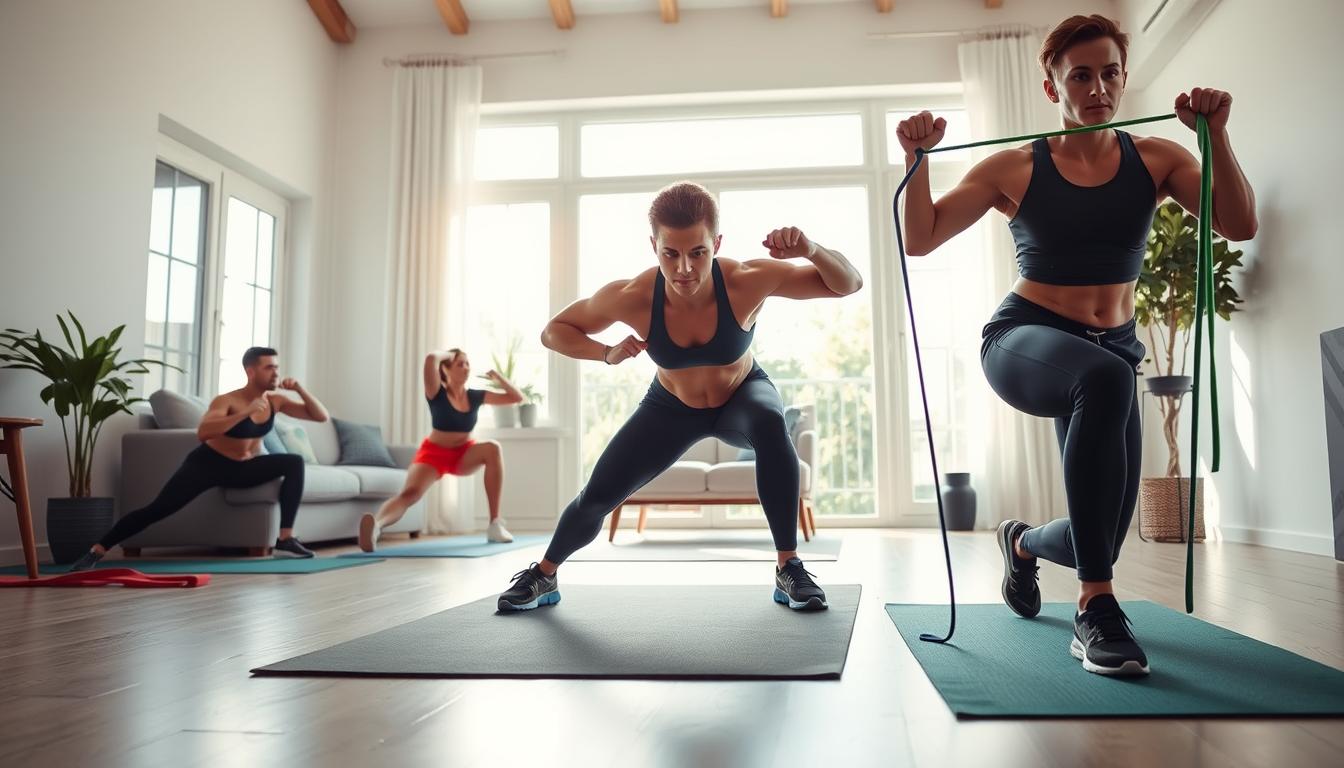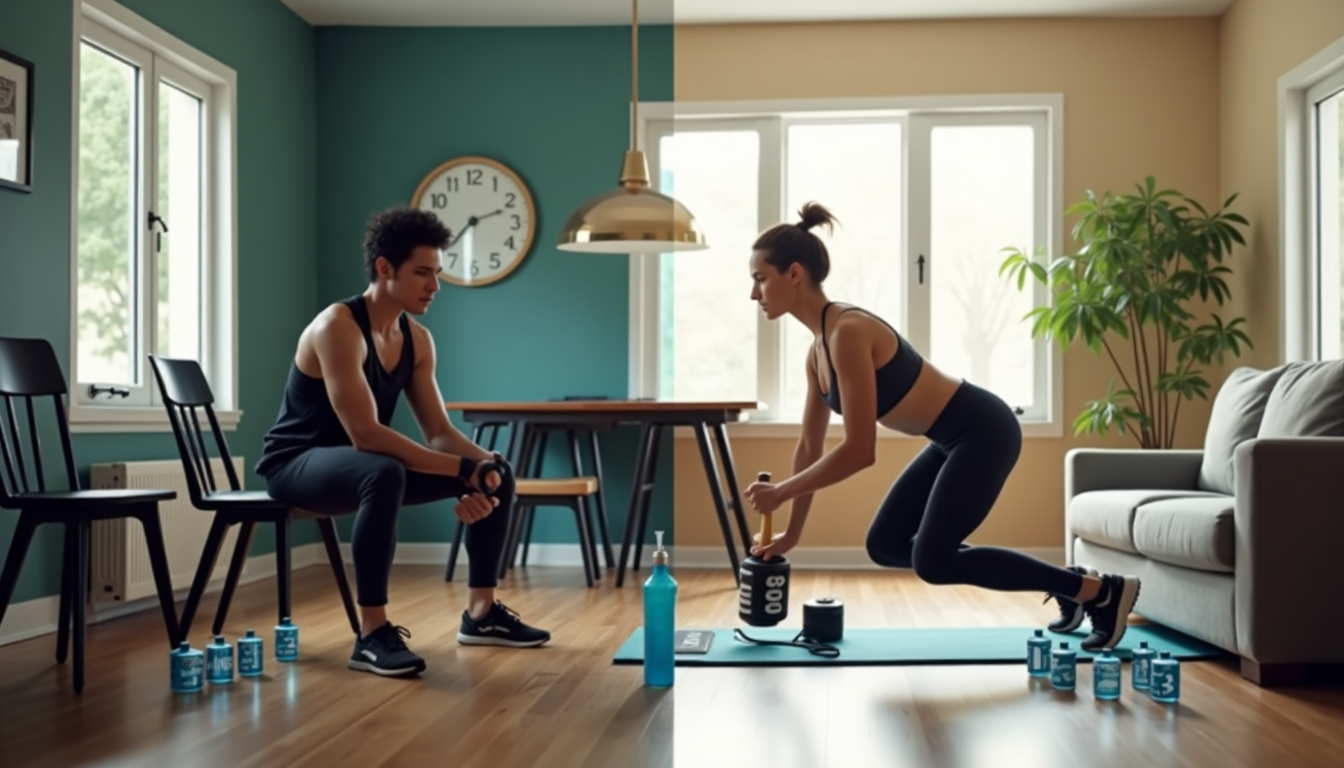Are you looking for a way to burn fat at home? You’re not alone. Many people are using bodyweight exercises to reach their fitness goals easily.
No equipment workout routines are popular for their simplicity and results. They can be done anywhere. This makes them perfect for those with busy lives or who prefer to exercise at home.
Adding fat burning exercises to your daily routine can lead to weight loss and better health. This article will show you the best home workouts. It will also help you understand how to start.
Key Takeaways
- Effective bodyweight exercises for fat loss
- Convenience of no equipment workouts
- Tips for creating a home workout routine
- Benefits of incorporating fat burning exercises
- Getting started with a no equipment workout plan
The Science Behind Bodyweight Fat-Burning Exercises
Bodyweight exercises are great for working out because they use your own weight. This makes them good for building strength, endurance, and losing fat.
How No-Equipment Workouts Activate Multiple Muscle Groups
Bodyweight exercises work many muscles at once. This is why they are so good for losing fat. For example, burpees, mountain climbers, and squat jumps work lots of muscles together. This means you burn more energy and get more metabolic benefits.
The Metabolic Benefits of High-Intensity Training
High-Intensity Training (HIIT) is great for burning fat. It involves short, intense workouts followed by rest. This kind of training boosts insulin sensitivity, increases HGH, and helps burn fat better.
Excess Post-Exercise Oxygen Consumption (EPOC) Effect
The EPOC effect is when your body uses more oxygen after working out. This makes your metabolism higher. HIIT workouts, in particular, cause a big EPOC effect. This leads to more fat loss and better fitness.
| Exercise Type | Muscle Groups Engaged | Metabolic Benefits |
|---|---|---|
| Burpees | Multiple (legs, core, arms) | High |
| Mountain Climbers | Core, legs | High |
| Squat Jumps | Legs, glutes | Moderate to High |
Benefits of Home Workouts to Burn Fat Without Equipment
Working out at home is convenient, cost-effective, and adaptable for burning fat. It saves time by not needing to go to the gym. This makes it easier to keep up with fitness goals.
Time Efficiency and Convenience
Home workouts save time. You don’t have to travel to a gym. This lets you fit in a workout even when your schedule is tight.
Plus, you can work out whenever you want. Whether it’s early morning or late at night, it fits your lifestyle.
Cost-Effectiveness
Home workouts are cost-effective. You don’t need expensive gym memberships or equipment. This makes fitness accessible to everyone, especially those on a budget.
Adaptability for All Fitness Levels
Home workouts are adaptable for all fitness levels. You can start with simple exercises and get more challenging as you get better. This lets you progress at your own pace.
It makes home workouts a sustainable long-term fitness solution.
Sustainable Long-Term Fitness Solution
Home workouts are sustainable because you can change them as you get better. This keeps your workouts interesting and prevents getting stuck in a routine. By adding new exercises and increasing intensity, you stay motivated and see lasting results.
In summary, home workouts are great for burning fat. They save time, are affordable, adaptable, and sustainable. They’re perfect for those who want to work out at home without needing any special equipment.
Essential Principles for Effective Fat Burning at Home
To burn fat at home, you need to know some key principles. Fat loss isn’t just about working out. It’s about working out right and doing it often.
Understanding Heart Rate Zones
Knowing heart rate zones is crucial. Working out in certain heart rate zones helps burn fat better. For example, the fat-burning zone is at 60-70% of your max heart rate. This is when your body uses fat for energy.
The Role of HIIT in Fat Loss
High-Intensity Interval Training (HIIT) is also key. HIIT means short, intense workouts followed by short breaks. It burns calories during and after the workout, helping you lose fat.
Progressive Overload Without Weights
You can do progressive overload without weights too. Increase reps, sets, or make exercises harder. This challenges your muscles, helping you lose fat and get stronger.
Consistency and Intensity Balance
It’s also important to balance consistency and intensity. Being consistent helps you make progress over time. But, intensity is what gets you results. Finding the right mix keeps you motivated and avoids burnout.
By following these principles, you can lose fat at home without any special equipment.
Preparing Your Body: Proper Warm-Up Techniques
A good warm-up is key to a great workout. It helps prevent injuries and boosts performance. Always prepare your body before exercising.
A good warm-up gets blood flowing to your muscles. It also raises your heart rate and gets your nervous system ready. You can do this with dynamic stretching, mobility exercises, and activation drills.
Dynamic Stretching Sequence
Dynamic stretching moves your joints and keeps your muscles active. It includes leg swings, arm circles, and torso twists. These improve flexibility and reduce stiffness.
- Leg Swings: Stand with your feet hip-width apart and swing one leg forward and backward, then switch to the other leg.
- Arm Circles: Hold your arms straight out to the sides and make small circles with your hands.
- Torso Twists: Stand with your feet shoulder-width apart and twist your torso to the left and right.
Mobility Exercises for Injury Prevention
Mobility exercises boost your joint range of motion. They include hip circles, ankle rotations, and knee lifts. This reduces injury risk during your workout.
Activation Drills for Key Muscle Groups
Activation drills target specific muscle groups, getting them ready for your workout. Examples are glute bridges, plank holds, and mountain climbers. These drills engage your muscles and enhance performance.
- Glute Bridges: Lie on your back with your knees bent and feet flat on the ground, then lift your hips towards the ceiling.
- Plank Holds: Start in a push-up position with your hands shoulder-width apart and hold steady for 30-60 seconds.
- Mountain Climbers: Begin in a plank position and bring one knee towards your chest, then quickly switch to the other knee.
Adding these warm-up techniques to your routine prepares you for your workout. It helps you reach your fitness goals.
Top Home Workouts to Burn Fat Without Equipment
Burning fat at home is easy and effective with the right exercises. You can choose exercises that fit your fitness level and goals. This ensures you lose fat in a complete way.
Full-Body HIIT Circuit
A Full-Body HIIT Circuit is great for burning fat at home. It includes a series of exercises done quickly with little rest in between.
Exercise Descriptions and Modifications
Effective exercises for HIIT include burpees, jump squats, mountain climbers, and plank jacks. You can adjust these to fit your fitness level. Beginners can start with simpler versions like squats without jumping or plank holds.
Rep and Set Recommendations
For HIIT, aim for 3-4 sets of 10-15 reps for each exercise. Rest for 30-60 seconds between sets. Adjust the intensity based on your fitness level.
Tabata-Style Workouts
Tabata is a form of HIIT with 20 seconds of all-out effort followed by 10 seconds of rest. This cycle is repeated for 4-6 rounds.
20-Second Work/10-Second Rest Protocol
The Tabata protocol is simple: work at maximum intensity for 20 seconds, then rest for 10 seconds. Repeat for the desired number of rounds.
Effective Exercise Combinations
Effective exercises for Tabata include sprints, burpees, jump squats, and mountain climbers. Doing these exercises in a Tabata format boosts your metabolism and burns fat.
Bodyweight Strength Training Sequence
Bodyweight strength training is effective for burning fat at home. It uses your body weight as resistance to build strength and endurance.
Push, Pull, and Core Exercises
Include push exercises (like push-ups), pull exercises (like pull-ups or body rows), and core exercises (like planks or Russian twists) in your routine. These exercises target different muscle groups for a balanced workout.
Lower Body Fat-Burning Movements
For the lower body, exercises like squats, lunges, and calf raises are effective. These can be done in HIIT or strength training sequences to maximize fat loss.
Common Mistakes to Avoid During Home Workouts
To get the most out of your home workouts, knowing the mistakes that can slow you down is key. Home workouts are great for burning fat and boosting fitness. But, some common errors can lessen their benefits.

Improper Form and Technique Issues
One big workout mistake is using the wrong form and technique. When doing bodyweight exercises, keeping the right form is crucial. It helps avoid injuries and makes sure you’re working the right muscles.
For example, when doing squats, keep your back straight and your knees behind your toes. This helps prevent joint strain.
Inadequate Recovery Time
Inadequate recovery time is another common error. Recovery is key for muscle repair and growth. It’s important to have enough recovery time between hard workouts.
This helps prevent overtraining and reduces injury risks.
Inconsistent Workout Schedule
Keeping a regular workout schedule is essential for reaching your fitness goals. An inconsistent workout schedule can slow your progress. It makes it hard to stick to a routine.
Having a set schedule and sticking to it helps you stay on track. It ensures you’re making steady progress.
Neglecting Progressive Overload
Neglecting progressive overload can make your workouts less effective. Progressive overload means gradually increasing workout intensity. This challenges your muscles and promotes growth and strength.
You can increase the number of reps, sets, or exercise difficulty over time. By avoiding these mistakes, you can make your home workouts more effective. This helps you reach your fitness goals faster.
Creating an Effective Workout Schedule
Making a good workout schedule is all about finding the right mix of hard workouts and rest. A well-planned schedule helps you reach your fat loss goals and keeps you going in the long run.
Balancing Intensity and Recovery
It’s key to balance how hard you work out and how much rest you get. Intensity pushes you forward, but recovery lets your body fix and get stronger. Without enough rest, you might get hurt and stop your fitness journey.
Try to mix up your days. For example, do a tough workout one day and then do something easy the next, like yoga or a walk.
Sample Weekly Workout Plans
Everyone needs a workout plan that fits their level. Here are some plans for beginners, those in the middle, and advanced athletes.
For Beginners (0-3 Months Experience)
- Monday: Full-body HIIT (20 minutes)
- Tuesday: Lower body strength training (30 minutes)
- Wednesday: Rest or active recovery
- Thursday: Upper body strength training (30 minutes)
- Friday: Full-body HIIT (20 minutes)
- Saturday and Sunday: Rest or active recovery
For Intermediate Fitness Levels (3-12 Months)
- Monday: High-intensity interval training (HIIT) with burpees and jump squats
- Tuesday: Strength training focusing on squats and lunges
- Wednesday: Active recovery or yoga
- Thursday: Strength training focusing on push-ups and rows
- Friday: HIIT with mountain climbers and sprints
- Saturday: Active recovery or a light jog
- Sunday: Rest
For Advanced Athletes (1+ Years)
- Monday: Advanced HIIT with complex movements
- Tuesday: Strength training with plyometric exercises
- Wednesday: Active recovery or mobility exercises
- Thursday: Strength training with an emphasis on core and stability
- Friday: Advanced HIIT with minimal rest
- Saturday: Active recovery or a challenging outdoor activity
- Sunday: Rest or a very light active recovery
| Fitness Level | Workout Frequency | Intensity Level |
|---|---|---|
| Beginner | 3-4 times per week | Moderate |
| Intermediate | 4-5 times per week | High |
| Advanced | 5-6 times per week | Very High |
Adapting Your Schedule to Life Demands
Life can change fast, and your workout plan should too. If you miss a workout, don’t worry. Just adjust your plan for the week to catch up.
Also, listen to your body. If you’re really tired or in pain, take an extra day off or do something easier.
Nutrition Strategies to Maximize Fat Loss
To lose fat, you need more than just home workouts. A good nutrition plan is key. It works well with bodyweight exercises to help you lose fat faster.
Pre and Post-Workout Nutrition
What you eat before and after working out matters a lot. Pre-workout nutrition should give you energy and help your muscles work better. Eating a meal with carbs and protein 1-2 hours before is good.
Post-workout nutrition helps your body recover and repair muscles. Drink a mix of protein and carbs within 30-60 minutes after working out. This helps refill energy and fix muscles.
Hydration Guidelines
Drinking enough water is important for health and working out. Try to drink 8-10 glasses of water a day. You might need more depending on how active you are and where you live.
Caloric Deficit Basics
To lose fat, you need to eat fewer calories than you burn. Aim for a 500-calorie daily deficit. This can help you lose about 1 pound a week.
Protein Requirements for Muscle Preservation
Protein is crucial for keeping and building muscle, especially when you’re eating fewer calories. Aim for 1.6 to 2.2 grams of protein per kilogram of your body weight every day.
Timing Meals Around Workouts
Eating at the right times can improve how well you work out and recover. Eat a balanced meal 1-2 hours before your workout. Then, have a recovery meal with protein and carbs within 30-60 minutes after.
| Nutrition Aspect | Recommendation | Benefits |
|---|---|---|
| Pre-Workout Nutrition | Balanced meal with carbs and protein 1-2 hours before workout | Provides energy, supports muscle function |
| Post-Workout Nutrition | Mix of protein and carbs within 30-60 minutes after workout | Supports recovery, muscle repair |
| Hydration | At least 8-10 glasses of water per day | Essential for health and performance |
| Caloric Deficit | 500 calories less than daily maintenance level | Promotes fat loss |
| Protein Intake | 1.6 to 2.2 grams per kilogram of body weight | Preserves muscle mass |
Using these nutrition tips can help you lose fat and reach your fitness goals faster.
Conclusion
Starting a fitness journey can be tough, but it’s doable with the right help. Home workouts are a great option because they’re easy, affordable, and fit your schedule. They help you burn fat and get fitter.
This article has given you the key tips for home workouts. You learned about bodyweight exercises and how to plan your workouts. Now, you can start your fitness path. Remember, keep improving and you’ll reach your fat loss goals.
By following this guide and sticking to your home workouts, you can change your body and health. Begin your journey now and enjoy a healthier, more active life through effective home workouts for fat loss.
FAQ
What are the most effective bodyweight exercises for burning fat at home?
Burpees, jump squats, mountain climbers, and plank jacks are great for burning fat at home. They work many muscles and can be done with high intensity.
How often should I do HIIT workouts for fat loss?
Do HIIT workouts 2-3 times a week for best fat loss. Make sure to rest well between sessions.
Can I achieve progressive overload without weights?
Yes, you can increase reps, sets, or decrease rest time without weights. You can also make exercises harder to challenge yourself.
How important is nutrition in a fat loss program?
Nutrition is key for fat loss. You need a caloric deficit to burn fat. Eat a balanced diet with lots of protein, moderate carbs, and less unhealthy fats.
What is the role of hydration in fat loss?
Hydration is vital for fat loss. It helps with body temperature, nutrient transport, and metabolism. Drink 8-10 glasses of water daily.
How can I create a workout schedule that fits my lifestyle?
Create a schedule based on your daily routine, fitness goals, and current fitness level. Start simple and adjust as needed to balance intensity and rest.
What are some common mistakes to avoid during home workouts?
Avoid using wrong form, not resting enough, being inconsistent, and not challenging yourself. These mistakes can hinder your progress.
How can I stay motivated to continue my home workout routine?
Stay motivated by tracking your progress, changing your workouts, and rewarding yourself. Having a workout buddy or joining online groups can also help.
Can I do bodyweight exercises if I’m a beginner?
Yes, bodyweight exercises can be modified for beginners. Start with easier exercises and gradually increase the challenge as you get more comfortable.
How long does it take to see results from home workouts?
Seeing results from home workouts depends on your fitness level, diet, and workout consistency. With regular exercise and a healthy diet, you can see changes in a few weeks.


